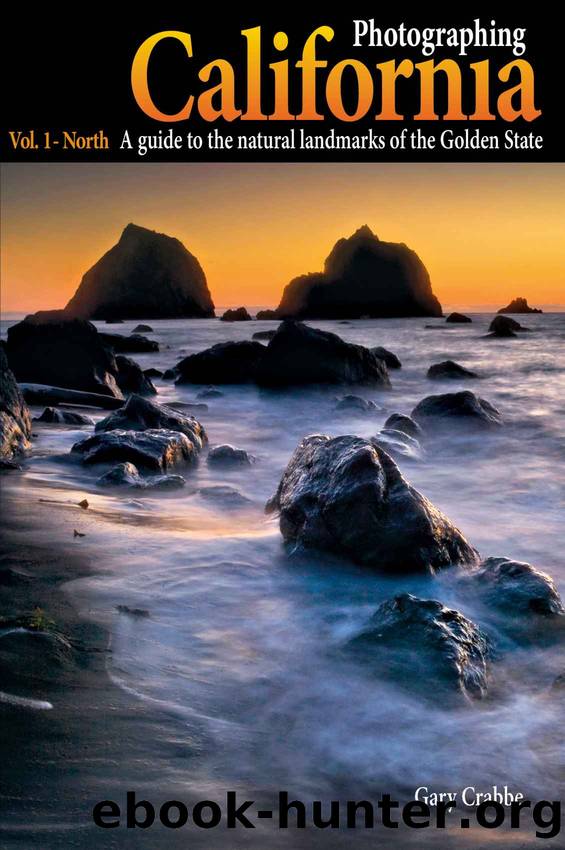Photographing California - Vol. 1: North: A Guide to the Natural Landmarks of the Golden State by Gary Crabbe

Author:Gary Crabbe [Crabbe, Gary]
Language: eng
Format: epub
Publisher: PhotoTripUSA Publishing
Published: 2014-09-03T00:00:00+00:00
Castle Dome (photo by Frank Kovalchek)
Photo Advice: Within the Castle Crags State Park, there is a drive-to viewpoint up a very narrow and winding forest road which is not suitable for larger recreational vehicles or trailers. The road, which works its way uphill for more than a mile from the park entrance, leads to a small parking area, where a short trail leads just 100 yards or so to a hilltop overlook. The biggest obstacles at this overlook are the nearby trees, which prevent really nice wider-angle scenic shots. Ideally, youâll want a telephoto lens to get more frame-filling compositions. From this viewpoint, youâre looking due west toward the crags, which means the granite peaks will get the best light in early morning. It would be a bonus to time your shot as the moon is setting in the western sky. Because this overlook is within the State Park, an entrance fee is required. Another good view of the Castle Crags can be seen from the south by taking Castle Creek Road past the park entrance for approximately 3.7 miles to where it makes a sharp climbing left-hand turn. Continue to follow the road for just under another mile uphill, where youâll see an obvious roadside dirt pullout with an unobstructed view looking north to the Castle Crags. The primary difference between this view and the one from the park overlook, is that the Crags themselves donât have the same jagged, incisor tooth-like appearance from this southerly vantage point, instead resembling a more rounded, though still sharp-crested molar.
Seasonally, the best time to visit the Castle Crags will be in the spring or fall. The waterfalls are usually flowing at their best during the latter part of spring, while spring and early summer will also be the best time to photograph wildflowers in the area, especially in the lower elevations along Castle Creek. The area is also home to the Castle Crags Harebell, a rare, area-specific wildflower which blooms nowhere else on the planet. The same lower elevations also offer good seasonal foliage for color photography in fall, especially when the leaves of the oak trees start turning a rich golden hue in October and November. Wildlife photographers in the area will most likely find common woodland creatures like deer and raccoons, while at higher elevations and throughout the wilderness, bears and rattlesnakes can sometimes be seen. If you plan on photographing Burstarse Falls and Root Creek Falls, both situated along the eastern facing slopes, you will have the best available light during the mornings and early afternoons.
Download
This site does not store any files on its server. We only index and link to content provided by other sites. Please contact the content providers to delete copyright contents if any and email us, we'll remove relevant links or contents immediately.
Shoot Sexy by Ryan Armbrust(17142)
Portrait Mastery in Black & White: Learn the Signature Style of a Legendary Photographer by Tim Kelly(16484)
Adobe Camera Raw For Digital Photographers Only by Rob Sheppard(16388)
Photographically Speaking: A Deeper Look at Creating Stronger Images (Eva Spring's Library) by David duChemin(16161)
Bombshells: Glamour Girls of a Lifetime by Sullivan Steve(13109)
Art Nude Photography Explained: How to Photograph and Understand Great Art Nude Images by Simon Walden(12348)
Perfect Rhythm by Jae(4621)
Pillow Thoughts by Courtney Peppernell(3397)
The Book of Joy by Dalai Lama(3218)
Good by S. Walden(2915)
The Pixar Touch by David A. Price(2740)
Fantastic Beasts: The Crimes of Grindelwald by J. K. Rowling(2543)
A Dictionary of Sociology by Unknown(2518)
Humans of New York by Brandon Stanton(2379)
Read This If You Want to Take Great Photographs by Carroll Henry(2303)
Stacked Decks by The Rotenberg Collection(2270)
On Photography by Susan Sontag(2131)
Photographic Guide to the Birds of Indonesia by Strange Morten;(2088)
Insomniac City by Bill Hayes(2084)
